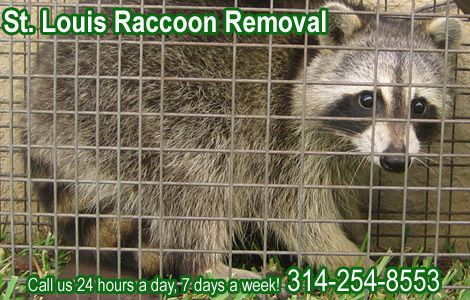Missouri Raccoon Information & Biology
Raccoon belong to a mammalia class. The word raccoon comes from a native powhatan language which means a “wildlife scratches with its hands” To understand the raccoon creature one should have the knowledge regarding its main features. Raccoons don’t hibernate they tend to sleep in their dens for weeks. Moreover a raccoon can run fast for at least 15 miles per hour; raccoons can swim very well and have the capacity to stay in water for many hours. Interesting thing about them is that they are capable of making different sounds vocal sounds such as whistles; they even make a sound of growls in order to scare the enemy, than the sound of snarls and screams. Different studies revealed that raccoons tend to remember learnt skills up to 3 years. The main features of raccoons are appended below:

- Size
- Physical appearance
- Life
- Food
- Location
- Habitant
- Life cycle
Size
Raccoon is of a medium size. Average if measured in inches could be from twenty four to thirty eight inches in length. With this size its weight can be 14 to 23 lbs or more. Since the weight depends on the areas and eating habits of the raccoon. Male raccoon is also called boar and comparatively they are large than their female counterparts.
Physical features
The most common feature of raccoon can be considered its black fur that mostly covers its eyes too. Raccoons mostly have grayish brown hair. The fur is so dense that it is used to protect the animal against the cold weather. The tail depicts five to 8 rings on it by changing the color of the fur on the tail. Raccoon’s front legs are shorter than the hind legs. His 5 toes of the front paws are work as expert fingers which help them to get hold of food faster and help him is grasping stuff in order to climb from one place to another. When one talks about raccoons senses well the first sense that comes in mind is it sense of touch which further increases when he is underwater.
Life
A raccoon can be as old as 20 years if it’s a pet but usually they life not more than two to three years.
Food
Raccoon’s diet depends on the environment he is in. Raccoon will keep eating food if he gets his hands on it. Mostly raccoon goes for fruits, cray fish, insects, eggs etc. If raccoon doesn’t find food in his environment he ends up in garbage cans to get his fill.
Location
Raccoon are were initially found in North America and all over USA expect few states such as Nevada Arizona etc. Raccoons are now found all over the globe specially in Russia and Germany.
Habitat
Raccoons initially lived in the tropics so that they can easily hunt for food along the riversides. With passage of time they move towards the north of the continent. On journey they kept adapting to the new environment in order to survive in it. Meaning they changed their eating habits to survive in the environment. They usually reside in trees or burrows and hunt early morning. Mostly their food is of frogs and while hunting they are alert about their enemy fox. Moreover their easily adapting skills lead them to live in city from mountains. In cities they have ample human food to eat and less afraid about their predator. The size of their body depends on the food supply they have their hands on. Furthermore raccoon cover one mile area for food hunt so more the food available in this areas huge would be the size of raccoon. Raccoon most hunts at night. Their mating season is in January to June.
Life cycle
Initially female raccoon shares den with other raccoons but when one gets pregnant she makes sure that everyone leaves the den. A female raccoon starts reproducing when she is nearly one year old. A female takes sixty five day to produce the kits. She produces at one time usually 2 to 5 kits and mostly the production period is spring. Since raccoons move in groups but when female raccoon produced the kit she gets separated from the group in order to raise the kids. The male raccoon has no part in raising the kit. Black den which is found on raccoons are also present on the kits body. Kits stay within den for eight to ten weeks as they are unable to provide them self with food and move around with mother for 13 to 14 months of age thus learning the skills to collect and eat food. When the raccoon is a year old it leaves the mother because it becomes an adult and ready to reproduce.
